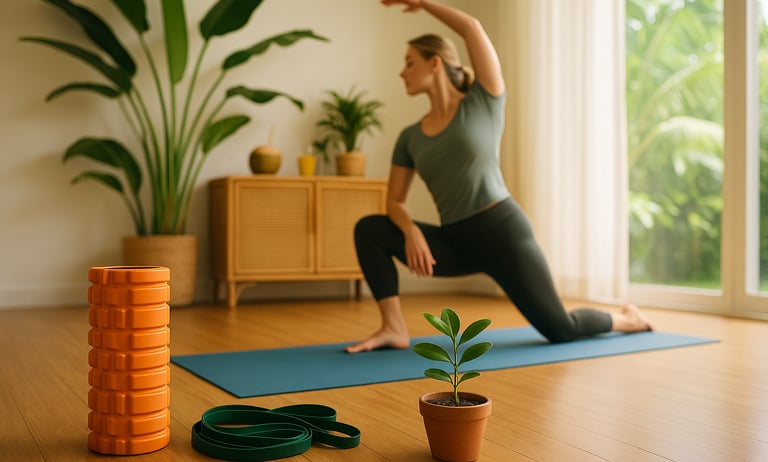Creating a Mobility-Friendly Space at Home or Work
Modern life demands adaptability, and having a dedicated space for mobility exercises can make incorporating movement into your daily routine effortless and enjoyable. A thoughtfully designed mobility-friendly environment at home or work can inspire consistency and help you achieve better physical and mental well-being.
MOBILITY
Ravisankar Lakshminarayanan
5/25/20252 min read


Creating a Mobility-Friendly Space at Home or Work
Modern life demands adaptability, and having a dedicated space for mobility exercises can make incorporating movement into your daily routine effortless and enjoyable. A thoughtfully designed mobility-friendly environment at home or work can inspire consistency and help you achieve better physical and mental well-being.
Why a Mobility-Friendly Space Matters
Convenience and Accessibility
A dedicated area eliminates excuses and makes daily movement more achievable.
Encourages Habit Formation
A specific space serves as a constant reminder to prioritize mobility.
Improved Focus and Energy
Regular mobility sessions can break up sedentary periods, boosting focus and energy levels.
Key Elements of a Mobility-Friendly Space
1. Location
Home: A quiet corner in the living room, bedroom, or patio.
Work: A small area near your desk or in a break room.
2. Flooring
Opt for non-slip, cushioned flooring like yoga mats, foam tiles, or rugs.
Ensure ample space for dynamic movements without obstacles.
3. Equipment
Essentials:
Yoga mat for stability and comfort.
Foam roller for myofascial release.
Resistance bands for strengthening and flexibility drills.
Small dumbbells or kettlebells (optional).
Optional Additions:
Stability ball for core work.
Mirror for posture alignment and form checks.
4. Lighting
Natural light is ideal for creating a calm and energizing atmosphere.
Use warm-toned lamps or dimmable lighting for a relaxing environment during evening sessions.
5. Organization
Use baskets, shelves, or hooks to store equipment neatly.
Avoid clutter to ensure a clear and inviting space.
Designing a Mobility Space at Home
Small Spaces
Use a foldable yoga mat or a compact foam roller.
Multi-functional furniture like ottomans with storage can hold your equipment.
Larger Spaces
Dedicate an entire room or section of a room for your mobility practice.
Add inspirational wall art or posters with movement guides.
Designing a Mobility Space at Work
Desk Area
Keep resistance bands in a drawer for quick stretches.
Use an under-desk foot rocker or balance board for ankle and foot mobility.
Break Rooms
Add a standing desk or counter for stretching during breaks.
Provide communal foam rollers or mats for employee use.
Outdoor Spaces
Use outdoor seating areas for short mobility sessions in fresh air.
Incorporate benches or railings for supported stretches.
Tips for Maximizing Your Mobility Space
Create a Routine: Use the space at the same time daily to build consistency.
Incorporate Music: Play calming or energizing tunes to set the mood.
Add Greenery: Plants can enhance the ambiance and promote relaxation.
Stay Connected: Use mobility apps or video tutorials to guide your exercises.
Minimize Distractions: Choose a space free from interruptions or noise.
Benefits of a Dedicated Mobility Space
Convenience: Everything you need is in one place.
Focus: A clutter-free, inviting environment fosters mindfulness.
Encouragement: Visual reminders of your goals motivate consistent practice.
Versatility: A multi-functional space can support a range of activities like yoga, stretching, and mobility drills.
Sample Routine for Your Mobility-Friendly Space
Morning Mobility Routine (10 Minutes)
Cat-Cow Stretch: 1 minute.
Hip Flexor Stretch with Side Reach: 2 minutes (1 minute each side).
Thoracic Spine Rotation: 2 minutes (1 minute each side).
Ankle Rocks: 2 minutes.
Downward Dog to Upward Dog Flow: 3 minutes.
Conclusion
Creating a mobility-friendly space at home or work is an investment in your health and well-being. Whether it’s a compact corner in your living room or a quiet spot at your workplace, designing a functional and inspiring environment will encourage you to move better and feel better every day.
Start small, personalize your space, and enjoy the transformative benefits of regular mobility practice.
Follow us
platanoorganic6@gmail.com
+919019754079
© 2025. All rights reserved.
FSSAI License no : 21223192000415
Platano Organic Foods
